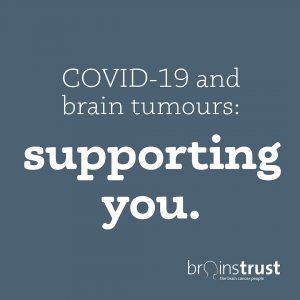What does the end of shielding and the easing of lockdown mean for people with a brain tumour?
Earlier in the year, the government announced details of a roadmap that will see lockdown restrictions across the UK easing. The first step of the roadmap started on 8th March, and this week we saw the start of step 2 which included the re-opening of non-essential retail, hairdressers and beauty salons, gyms and hospitality outdoors.
For the best part of a year, the government advised people who were deemed to be ‘clinically extremely vulnerable’ to shield in order to protect themselves from Coronavirus. Shielding guidance officially ended on 1st April 2021.
Whilst Coronavirus hasn’t gone away, we now know enough about it to make sure we can take the necessary precautions to protect ourselves. We now also have better access to testing for Coronavirus and to date, over 32 million people in the UK have received at least the first dose of the Coronavirus vaccination.
As the country starts to open back up, what does this mean for people living with a brain tumour diagnosis?
Meeting up with loved ones
For many of us, having to be away from those closest to us, has been incredibly difficult. Now we are able to meet up with friends and family outside, this means we can start to spend valuable time with loved ones, and start to regain social connections that are so important to our day to day lives.
However, if you still have concerns around meeting up with others, then there is still the option of being able to connect with people online – something which has been invaluable for keeping us connected with others during this time. For brainstrust, by introducing an online events programme, we have been able to reach more of you than ever, and we will be continuing to deliver our webinars and meetups virtually for the foreseeable. You can view our online events programme here.
“brainstrust and the Facebook group has provided me with a unique and much needed social contact lifeline”
Returning to work
Another change this week means that lots of other businesses are now opening up. Whilst it is still advised that people work from home if they are able to, there will be many cases where this is not possible. Employers have been issued with specific government guidance regarding how they need to ensure that workplaces are safe, as well as guidance for people who may have concerns and where you can report these to, which you can find here.
For people who have been required to shield during this time, there has been extra support in place to ensure they have access to supermarket delivery slots and help with collecting medications. Despite shielding coming to an end, these services are still available for people who registered before 31st March, and will be available until 21st June. You can find out more about this here.
“I’m not overly concerned with the lifting of lockdown. I cautiously welcome it and if I do feel uncomfortable, I can always revisit my personal style of shielding”
The last year has bought lots of different challenges for everybody, and thanks to your support, we have been able to remain to be there for people with a brain tumour diagnosis at a time when they have needed us the most and will continue to do so.
If you are in need of support, or have any concerns about Coronavirus when living with a brain tumour diagnosis, you can get in touch with us by calling our helpline on 01983 292 405, or email us on hello@brainstrust.org.uk











